Numerical and Experimental Study on the Colliding Flow Pulp Conditioning for the Separation Intensification of Unburned Carbon from Coal Gasification Slag
Abstract
:1. Introduction
2. Colliding Flow Pulp Conditioning Device
3. Numerical Simulations
3.1. Governing Equations
3.2. Numerical Methods
3.3. Numerical Simulation Results
3.3.1. Velocity Analysis
3.3.2. Strain Rate Analysis
3.3.3. Turbulent Kinetic Energy and Dissipation Rate Analysis
3.3.4. Turbulent Eddy Scale Analysis
4. Experiments
4.1. Materials
4.2. Methods
4.3. Experimental Results and Discussion
4.3.1. Wrap Angle Analysis
4.3.2. Flotation Results
5. Conclusions
Author Contributions
Funding
Data Availability Statement
Conflicts of Interest
References
- Xue, Z.; Dong, L.; Fan, M.; Yang, H.; Liu, A.; Li, Z.; Bao, W.; Wang, J.; Fan, P. Enhanced flotation mechanism of coal gasification fine slag with composite collectors. Colloids Surf. A Physicochem. Eng. Asp. 2022, 641, 128593. [Google Scholar] [CrossRef]
- Yu, W.; Zhang, H.; Wang, X.; Rahman, Z.U.; Shi, Z.; Bai, Y.; Wang, G.; Chen, Y.; Wang, J.; Liu, L. Enrichment of residual carbon from coal gasification fine slag by spiral separator. J. Environ. Manag. 2022, 315, 115149. [Google Scholar] [CrossRef]
- Yuan, N.; Zhao, A.; Hu, Z.; Tan, K.; Zhang, J. Preparation and application of porous materials from coal gasification slag for wastewater treatment: A review. Chemosphere 2021, 287, 132227. [Google Scholar] [CrossRef] [PubMed]
- Liu, X.; Jin, Z.; Jing, Y.; Fan, P.; Qi, Z.; Bao, W.; Wang, J.; Yan, X.; Lv, P.; Dong, L. Review of the characteristics and graded utilisation of coal gasification slag. Chin. J. Chem. Eng. 2021, 35, 92–106. [Google Scholar] [CrossRef]
- Blaisi, N.I.; Roessler, J.G.; Watts, B.E.; Paris, J.; Ferraro, C.C.; Townsend, T.G. Construction material properties of high temperature arc gasification slag as a portland cement replacement. J. Clean. Prod. 2018, 196, 1266–1272. [Google Scholar] [CrossRef]
- Guo, F.; Miao, Z.; Guo, Z.; Li, J.; Zhang, Y.; Wu, J. Properties of flotation residual carbon from gasification fine slag. Fuel 2020, 267, 117043. [Google Scholar] [CrossRef]
- Guo, F.; Guo, Y.; Qiu, G.; Xu, J.; Niu, Y.; Zhang, Y.; Jiang, L.; Hu, X.; Wu, J.; Zhang, H. A new separation flowsheet for resources recovery from waste coal gasification fine slag black water and its benefits analysis. Process. Saf. Environ. Prot. 2022, 164, 836–845. [Google Scholar] [CrossRef]
- Zhang, Y.; Zhu, H.; Zhu, J.; Shi, Q.; Yin, J.; Xu, D.; Valdivieso, A.L. Characteristic evolution and energy variation during the generation of kerosene droplet. Fuel 2020, 288, 119684. [Google Scholar] [CrossRef]
- Zhu, X.; Wei, H.; Hou, M.; Wang, Q.; You, X.; Li, L. Thermodynamic behavior and flotation kinetics of an ionic liquid microemulsion collector for coal flotation. Fuel 2019, 262, 116627. [Google Scholar] [CrossRef]
- Shen, L.; Min, F.; Liu, L.; Zhu, J.; Xue, C.; Cai, C.; Zhou, W.; Wang, C. Application of gaseous pyrolysis products of the waste cooking oil as coal flotation collector. Fuel 2018, 239, 446–451. [Google Scholar] [CrossRef]
- Wang, H.; Liang, Y.; Li, D.; Chen, R.; Yan, X.; Zhang, H. Collisional interaction process between a bubble and particles with different hydrophobicity. Sep. Purif. Technol. 2022, 301, 121940. [Google Scholar] [CrossRef]
- Wang, Y.; Zhou, Y.; He, Q.; Xing, Y.; Bao, X.; Gui, X.; Wang, L. Research on Mechanisms of Improving Flotation Selectivity of Coal Slime by Adding Sodium Polyphosphate. Minerals 2022, 12, 1392. [Google Scholar] [CrossRef]
- Yang, R.; Shen, L.; Wang, H. Research on emulsified tyre pyrolysis oil as a coal flotation collector. Physicochem. Probl. Miner. Process. 2017, 53, 279–287. [Google Scholar]
- Wang, H.; Yang, W.; Li, D.; Zhang, C.; Yan, X.; Wang, L.; Zhang, H. Enhancement of coal flotation using impact flow conditioning pulp. J. Clean. Prod. 2020, 267, 122124. [Google Scholar] [CrossRef]
- Li, D.; Zhang, C.; Li, X.; Yang, L.; Yan, X.; Wang, L.; Liu, Q.; Zhang, H. Experimental study on the preconditioning of fine coal particles surface modification using a new type flow mixer. Fuel 2020, 268, 117361. [Google Scholar] [CrossRef]
- Fan, G.; Zhang, M.; Peng, W.; Zhou, G.; Deng, L.; Chang, L.; Cao, Y.; Li, P. Clean products from coal gasification waste by flotation using waste engine oil as collector: Synergetic cleaner disposal of wastes. J. Clean. Prod. 2020, 286, 124943. [Google Scholar] [CrossRef]
- Shi, D.; Zhang, J.; Hou, X.; Li, S.; Li, H.; He, F. Adsorption mechanism of a new combined collector (PS-1) on unburned carbon in gasification slag. Sci. Total. Environ. 2021, 818, 151856. [Google Scholar] [CrossRef]
- Zhang, R.; Guo, F.; Xia, Y.; Tan, J.; Xing, Y.; Gui, X. Recovering unburned carbon from gasification fly ash using saline water. Waste Manag. 2019, 98, 29–36. [Google Scholar] [CrossRef]
- Evans, G.M.; Doroodchi, E.; Lane, G.L.; Koh, P.T.L.; Schwarz, M.P. Mixing and gas dispersion in mineral flotation cells. Chem. Eng. Res. Des. 2008, 86, 1350–1362. [Google Scholar] [CrossRef]
- Engel, M.; Middlebrook, P.; Jameson, G. Advances in the study of high intensity conditioning as a means of improving mineral flotation performance. Miner. Eng. 1997, 10, 55–68. [Google Scholar] [CrossRef]
- Yang, L.; Li, D.; Zhu, Z.; Xu, M.; Yan, X.; Zhang, H. Effect of the intensification of preconditioning on the separation of unburned carbon from coal fly ash. Fuel 2019, 242, 174–183. [Google Scholar] [CrossRef]
- Feng, B.; Lu, Y.-p.; Feng, Q.-m.; Ding, P.; Luo, N. Mechanisms of surface charge development of serpentine mineral. Trans. Nonferrous Met. Soc. China 2013, 23, 1123–1128. [Google Scholar] [CrossRef]
- Yu, Y.; Cheng, G.; Ma, L.; Huang, G.; Wu, L.; Xu, H. Effect of agitation on the interaction of coal and kaolinite in flotation. Powder Technol. 2017, 313, 122–128. [Google Scholar] [CrossRef]
- Wang, W.; Liu, D.; Tu, Y.; Jin, L.; Wang, H. Enrichment of residual carbon in entrained-flow gasification coal fine slag by ultrasonic flotation. Fuel 2020, 278, 118195. [Google Scholar] [CrossRef]
- Nguyen, A.V.; An-Vo, D.-A.; Tran-Cong, T.; Evans, G.M. A review of stochastic description of the turbulence effect on bubble-particle interactions in flotation. Int. J. Miner. Process. 2016, 156, 75–86. [Google Scholar] [CrossRef]
- Yang, L.; Zhu, Z.; Qi, X.; Yan, X.; Zhang, H. The Process of the Intensification of Coal Fly Ash Flotation Using a Stirred Tank. Minerals 2018, 8, 597. [Google Scholar] [CrossRef] [Green Version]
- Zheng, K.; Yan, X.; Wang, L.; Zhang, H.; Cao, Y.; Guo, C. Turbulent effects of vortex generators on the separation of fine particles. Chem. Eng. J. 2021, 418, 129373. [Google Scholar] [CrossRef]

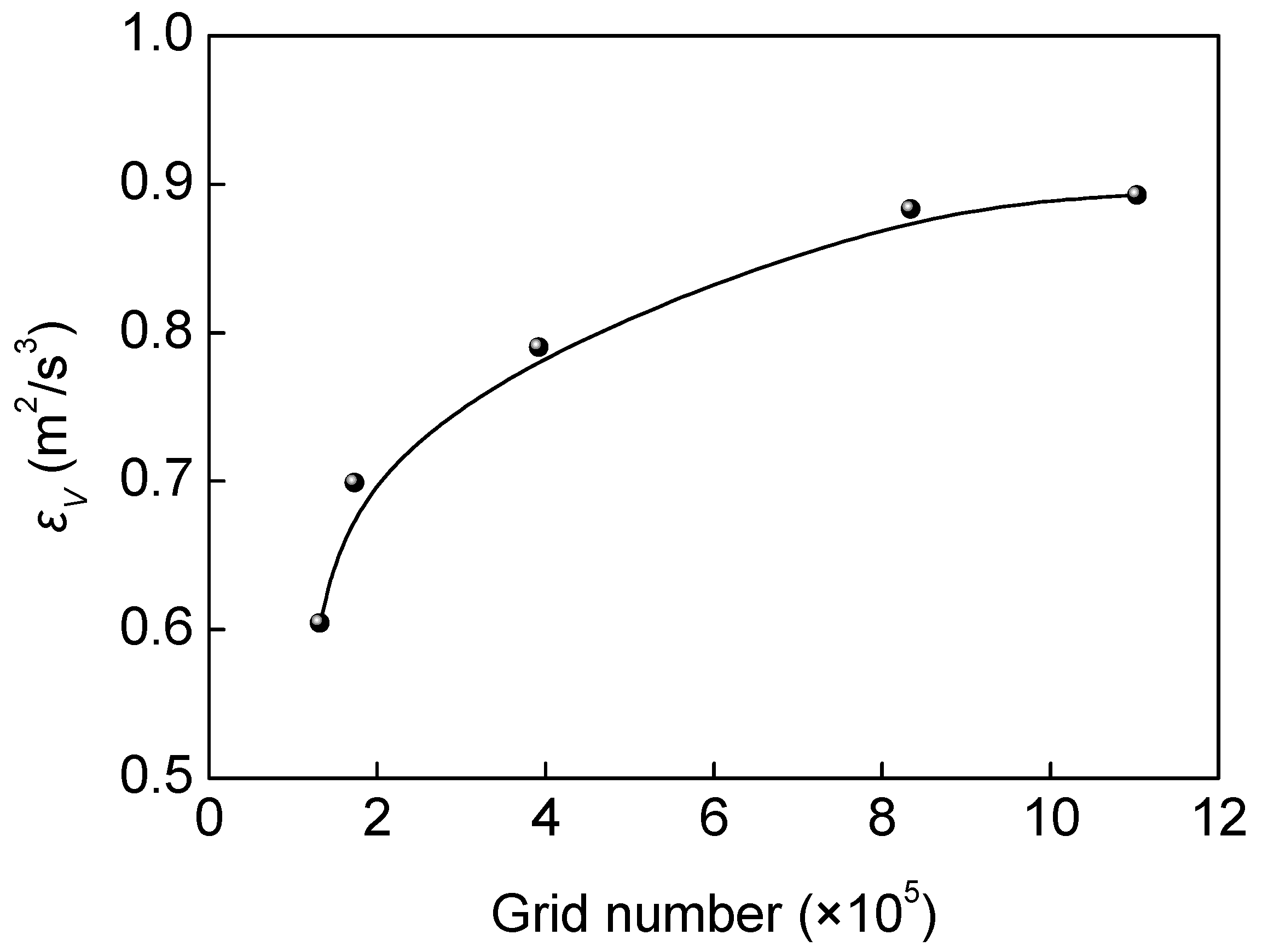



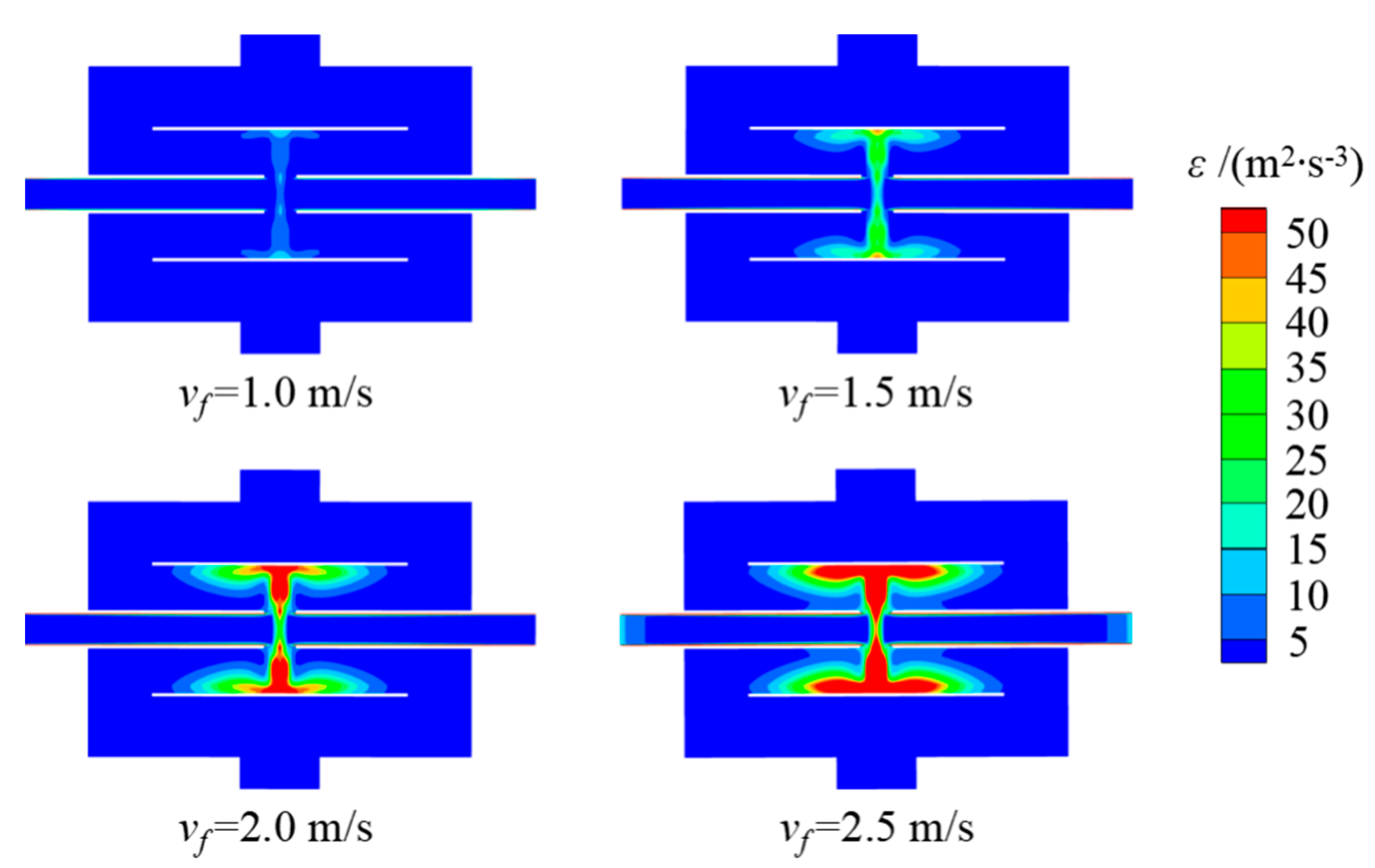

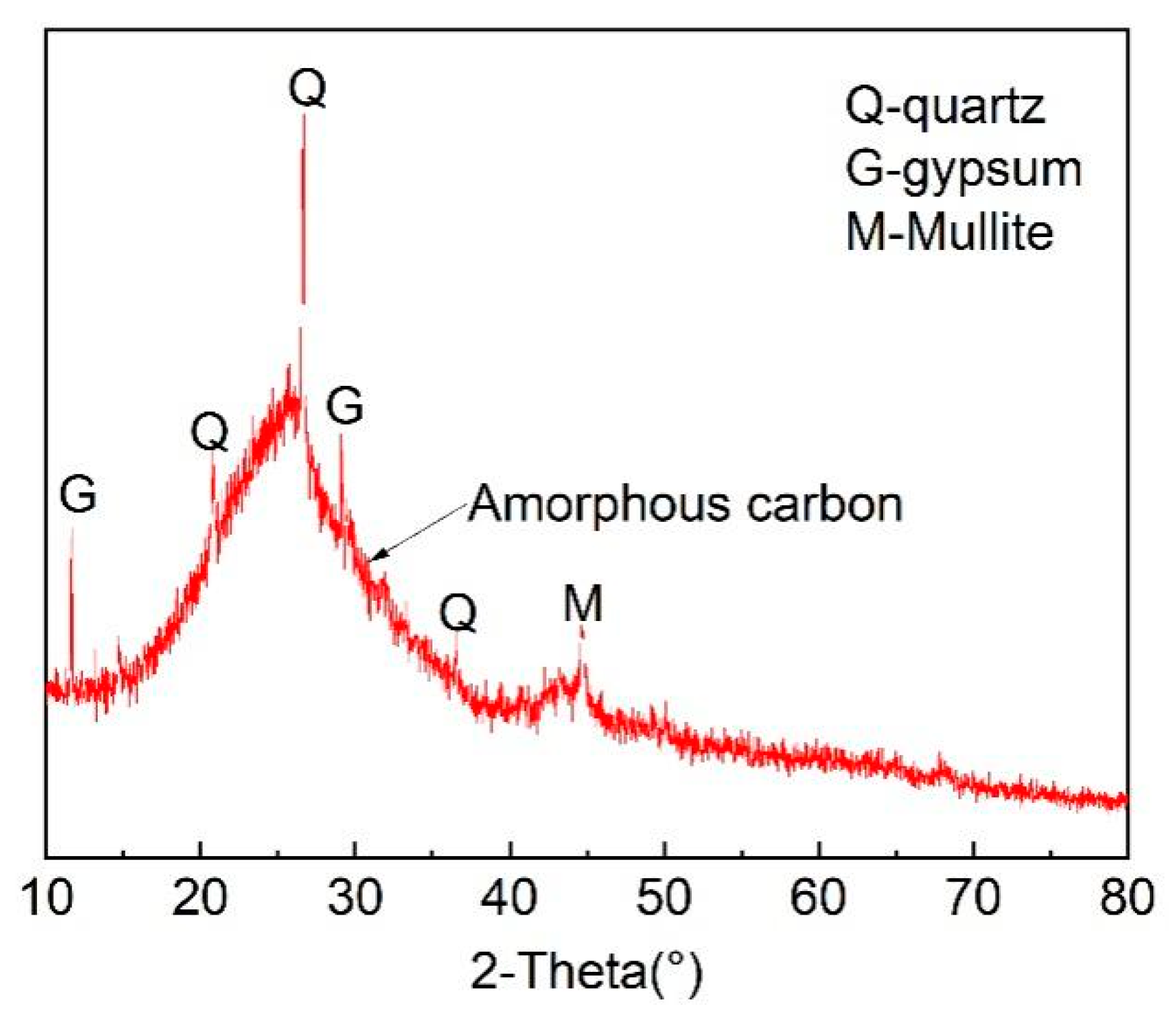

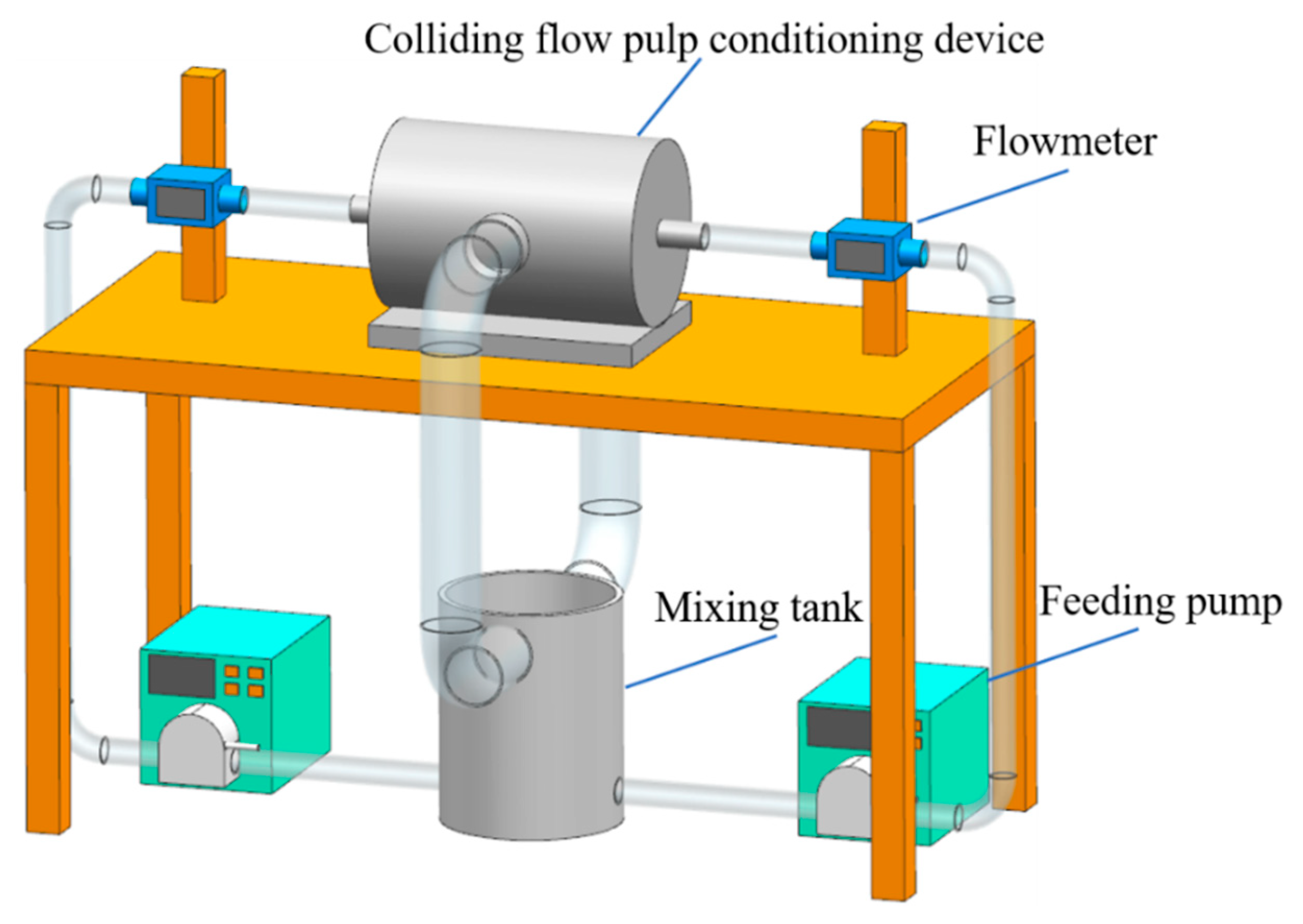
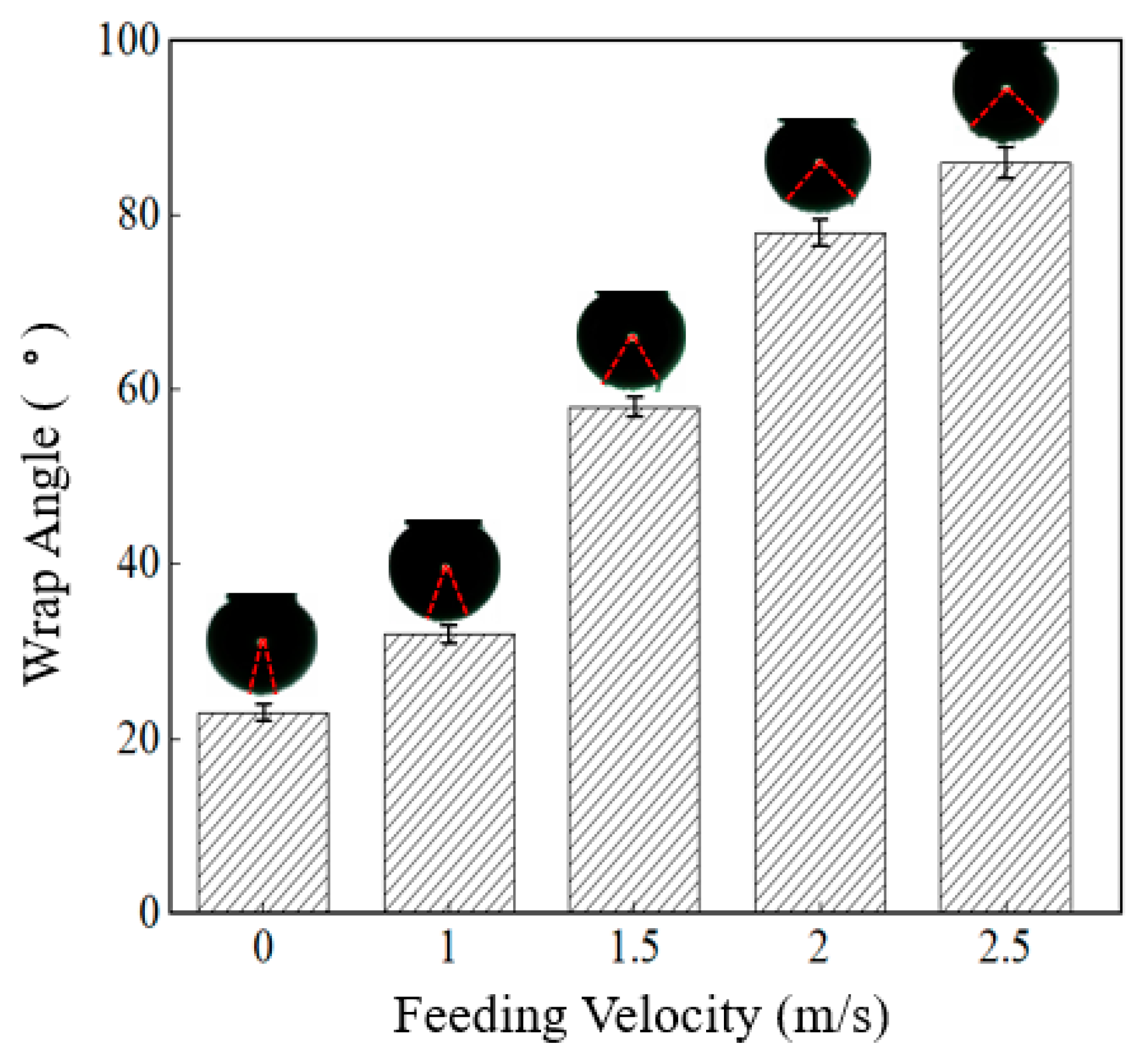
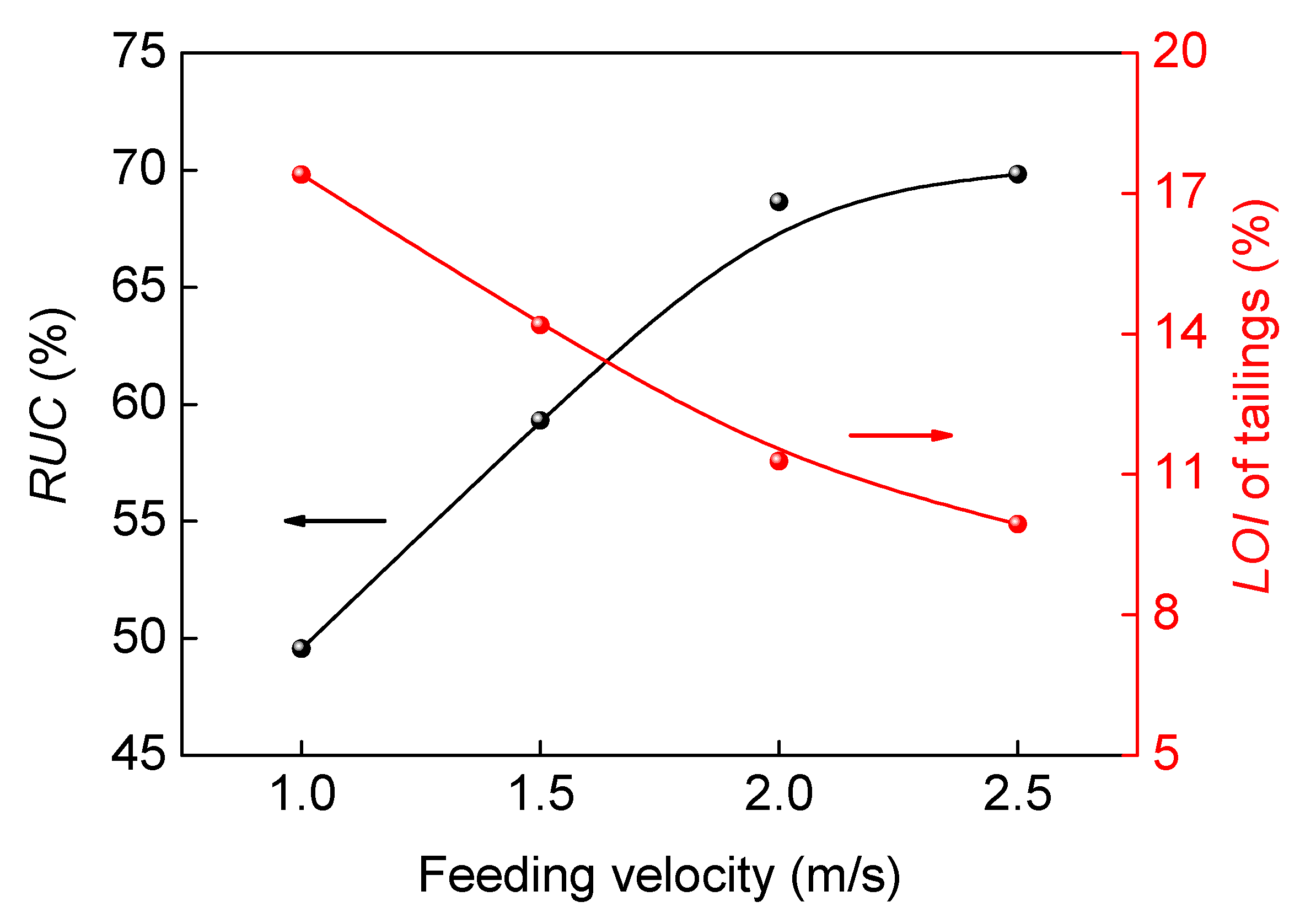
| Proximate Analysis (ad, %) | Ultimate Analysis (daf, %) | |||||||
|---|---|---|---|---|---|---|---|---|
| M | A | V | FC # | C | H | N | S | O # |
| 2.30 | 74.52 | 4.39 | 18.79 | 94.61 | 2.29 | 0.60 | 0.75 | 1.75 |
| Feeding Velocity (m/s) | Yield (%) | Ash Content (%) | ||
|---|---|---|---|---|
| Concentrate | Tailings | Concentrate | Tailings | |
| 1.0 | 30.69 | 69.31 | 59.67 | 82.60 |
| 1.5 | 34.49 | 65.51 | 57.06 | 85.81 |
| 2.0 | 39.68 | 60.32 | 56.80 | 88.72 |
| 2.5 | 39.33 | 60.67 | 55.67 | 90.06 |
Disclaimer/Publisher’s Note: The statements, opinions and data contained in all publications are solely those of the individual author(s) and contributor(s) and not of MDPI and/or the editor(s). MDPI and/or the editor(s) disclaim responsibility for any injury to people or property resulting from any ideas, methods, instructions or products referred to in the content. |
© 2023 by the authors. Licensee MDPI, Basel, Switzerland. This article is an open access article distributed under the terms and conditions of the Creative Commons Attribution (CC BY) license (https://creativecommons.org/licenses/by/4.0/).
Share and Cite
Chen, R.; Wang, H.; Li, D.; Liao, Y.; Tian, Q.; Su, W.; Li, L.; Zhang, H. Numerical and Experimental Study on the Colliding Flow Pulp Conditioning for the Separation Intensification of Unburned Carbon from Coal Gasification Slag. Minerals 2023, 13, 398. https://doi.org/10.3390/min13030398
Chen R, Wang H, Li D, Liao Y, Tian Q, Su W, Li L, Zhang H. Numerical and Experimental Study on the Colliding Flow Pulp Conditioning for the Separation Intensification of Unburned Carbon from Coal Gasification Slag. Minerals. 2023; 13(3):398. https://doi.org/10.3390/min13030398
Chicago/Turabian StyleChen, Ruifeng, Hainan Wang, Danlong Li, Yinfei Liao, Quanzhi Tian, Wanli Su, Lei Li, and Haijun Zhang. 2023. "Numerical and Experimental Study on the Colliding Flow Pulp Conditioning for the Separation Intensification of Unburned Carbon from Coal Gasification Slag" Minerals 13, no. 3: 398. https://doi.org/10.3390/min13030398
APA StyleChen, R., Wang, H., Li, D., Liao, Y., Tian, Q., Su, W., Li, L., & Zhang, H. (2023). Numerical and Experimental Study on the Colliding Flow Pulp Conditioning for the Separation Intensification of Unburned Carbon from Coal Gasification Slag. Minerals, 13(3), 398. https://doi.org/10.3390/min13030398








